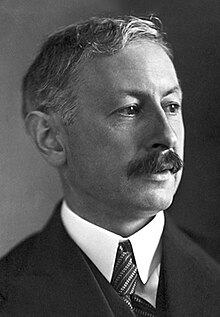Paul Karrer
This article includes a list of generalreferences,butit lacks sufficient correspondinginline citations.(October 2009) |
Paul Karrer | |
|---|---|
 | |
| Born | 21 April 1889 Moscow,Russia |
| Died | 18 June 1971(aged 82) Zürich,Switzerland |
| Nationality | Swiss |
| Alma mater | Old Cantonal School Aarau(Matura) University of Zurich(PhD) |
| Known for | Vitamins |
| Awards | Marcel Benoist Prize(1922) Nobel Prize for Chemistry(1937) |
| Scientific career | |
| Fields | Chemistry |
| Institutions | University of Zurich |
Paul Karrer(21 April 1889 – 18 June 1971) was a Swissorganic chemistbest known for his research onvitamins.He andNorman Haworthwon theNobel Prize for Chemistryin 1937.
Biography
[edit]Early years
[edit]Karrer was born inMoscow,Russiato Paul Karrer and Julie Lerch, both Swiss nationals. In 1892 Karrer's family returned toSwitzerlandwhere he was educated atWildeggand at theOld Cantonal School Aarauwhere he matriculated in 1908. He studiedchemistryat theUniversity of ZurichunderAlfred Wernerand after gaining hisPh.D.in 1911, he spent a further year as an assistant in the Chemical Institute. He then took a post as a chemist withPaul Ehrlichat theGeorg Speyer Haus,Frankfurt-am-Main.In 1919 he became Professor of Chemistry and Director of the Chemical Institute.
Research
[edit]Karrer's early research concerned complex metal compounds but his most important work has concernedplant pigments,particularly the yellowcarotenoids.He elucidated their chemical structure and showed that some of these substances are transformed in the body intovitamin A.His work led to the establishment of the correct constitutional formula forbeta-carotene,the chief precursor of vitamin A; the first time that the structure of a vitamin or provitamin had been established.George Waldworked briefly in Karrer's lab while studying the role of vitamin A in theretina.Later, Karrer confirmed the structure ofascorbic acid(vitamin C) and extended his researches into the vitamin B2and E. His important contributions to the chemistry of theflavinsled to the identification oflactoflavinas part of the complex originally thought to bevitamin B2.
Karrer published many papers and received many honours and awards, including theNobel Prizein 1937. His textbookLehrbuch der Organischen Chemie (Textbook of Organic Chemistry)was published in 1927, went through thirteen editions, and was published in seven languages.[citation needed]
Personal life
[edit]Karrer married Helena Froelich in 1914 and had three sons, one of whom died in infancy.[1]He died on 18 June 1971, at the age of 82 inZürich.His wife died in 1972.[citation needed]
Legacy
[edit]The prestigiousPaul Karrer Gold Medaland lecture were established in his honour in 1959 by a group of leading companies such as CIBA AG, J.R. Geigy, F. Hoffmann-La Roche & Co. AG, Sandoz AG, Société des Produits Nestlé AG and Dr. A. Wander AG. It is awarded annually or biannually to an outstanding chemist who delivers a lecture at theUniversity of Zurich.[2]
The Paul Karrer Lecture Foundation is based at the Chemistry Institute of the University of Zurich at Rämistrasse 71, inZürich.[3]
References
[edit]- Sources
- Shampo; Kyle, RA (2000)."Paul Karrer—research on vitamins".Mayo Clinic Proceedings.75(4): 328.doi:10.4065/75.4.328.PMID10761480.
- Isler (1978). "Paul Karrer, 21 April 1889—18 June 1971".Biographical Memoirs of Fellows of the Royal Society.24:245–321.doi:10.1098/rsbm.1978.0009.PMID11615740.S2CID7389730.
- Schmid (1972). "Paul Karrer, 1889–1971".Bulletin der Schweizerischen Akademie der Medizinischen Wissenschaften.28(5): 367–70.PMID4566692.
- Roche (1972). "Paul Karrer (1889–1971)".Bulletin de l'Académie Nationale de Médecine.156(4): 89–92.PMID4565808.
- Karrer; Viscontini, M; Hochreuter, R (1953). "Crystallized 3-carboxamide-N1-D-ribosidopyridinium bromide and related compounds".Biochimica et Biophysica Acta.12(1–2): 51–5.doi:10.1016/0006-3002(53)90122-x.PMID13115412.
- Notes
- ^Isler, page 245
- ^"Paul Karrer Lecture".University of Zurich. Archived fromthe originalon 20 January 2015.Retrieved20 January2015.
- ^"Paul Karrer Vorlesung".Institut für Chemie.
External links
[edit]- Paul Karreron Nobelprize.orgincluding the Nobel Lecture, 11 December 1937Carotenoids, Flavins and Vitamin A and B2
- 1889 births
- 1971 deaths
- Organic chemists
- People associated with the University of Zurich
- Swiss chemists
- Nobel laureates in Chemistry
- Swiss Nobel laureates
- Foreign members of the Royal Society
- Foreign associates of the National Academy of Sciences
- Honorary Fellows of the Royal Society of Edinburgh
- Swiss biochemists
- Paul Ehrlich Institute people
- Vitamin researchers

